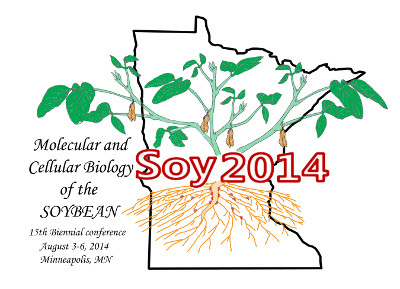
AGENDA
The Commons Hotel, Minneapolis, MN
Sunday, August 3, 2014
Plenary Address
Dan Voytas, University of Minnesota
Engineering the Soybean Genome with Precision
Monday, August 4, 2014
Plenary Address
James Specht, University of Nebraska
Forty years of Fun in Soybean Genetic Improvement - Retrospect and Prospect (Oh! The places you will go!)
Pests and Diseases
Chairs: Andrew Bent, University of Wisconsin and Ann Dorrance, Ohio State University
9:00 - 9:20, Leonor Leandro, Iowa State University
Investigating Mechanisms of Foliar Resistance to Fusarium virguliforme Toxins Using Virus-Induced Gene Silencing
9:20 - 9:40, Andrew Brent, University of Wisconsin
SCN Resistance: A Major Plant Disease Resistance Trait Operates Via Novel Mechanisms
9:40 - 10:00, Leah McHale, Ohio State University
Genome-Wide Analyses of Quantitative Resistance to Phytophthora sojae in Soybean
10:15 - 10:35, Brett Tyler, Oregon State University
Using Pathogen Genomics and Effector Biology to Improve Oomycete Disease Management in Soybean
10:35 - 10:55, Maria Ortega, University of Georgia
QTL Pyramids for Effective Resistance to Chewing Insects
10:55 - 11:15, Andy Michel, Ohio State University
Molecular Interactions among Soybean and Soybean Aphid
11:15 - 11:35, Tom Ashfield, Indiana University
Using Domain Swaps to Identify the Regions Determining Recognition Specificity in Soybean Resistance Genes Effective Against Bacterial Blight
11:35 - 11:55, Yong Bao, University of Minnesota
Symbiotic Interactions
Chairs: Michelle Graham, USDA-ARS, Iowa State University and Janine Sherrier, University of Delaware
1:30 - 1:50, Perry Cregan, USDA-ARS, Beltsville, MD
1:50 - 2:10, Md Shakhawat Hossain, University of Missouri
Root Hair, a Single Cell Model to Study Soybean-Microbe Interactions and Abiotic Stress
2:10 - 2:30, Brent Kaiser, The University of Adelaide, Australia
A Membrane Localized BHLH Transcription Factor Involved in Legume Nodule Development and Ammonium Transport
2:30 - 2:50, Suresh Damodaran, South Dakota State University
Regulation of HD-ZIP III Transcription Factor during Soybean Nodule Development
Abiotic Stress
Chairs: Jamie O'Rourke, USDA-ARS, Iowa State University and Henry Nguyen, University of Missouri
3:10 - 3:30, Zenglu Li, University of Georgia
Utilizing Genomic Tools to Improve Drought Tolerance in Soybean
3:30 - 3:50, Adrienne Moran Lauter, Iowa State University
Investigating Gene Expression Changes in the Iron-Efficiency Response of Soybean by RNA-Seq and Virus-Induced Gene Silencing
3:50 - 4:10, Silvas Prince, University of Missouri
Integration of Genomic and Genetic Approaches to Improve Soybean Root Architecture
4:10 - 4:30, Kent Burkey, USDA-ARS, Raleigh, NC
Examining the Basis for Ozone Tolerance in Soybean
4:30 - 4:50, Bishal Tamang, Virginia Tech
Physiological and Transcriptomic Responses to Submergence and Reoxygenation in Soybean at the Seedling Establishment Stage
Tuesday, August 5, 2014
Composition/Nutrition
Chairs: Brian Diers, University of Illinois and Katy Martin Rainey, Purdue University
8:15 - 8:35, Karen Hudson, USDA-ARS, West Lafayette, IN
Genomic Mutation Breeding for Seed Composition
8:35 - 8:55, John Everard, DuPont Pioneer
Improving the Composition of Soybean Seeds
8:55 - 9:15, Hari Krishnan, USDA-ARS, Columbia, MO
A Multifaceted Approach to Improve the Protein Quality of Soybean Seed
9:15 - 9:35, Qijian Song, USDA-ARS, Beltsville, MD
Identification of Loci Associated with Protein and Oil Content in Soybean
9:35 - 9:55, Minviluz Stacey, University of Missouri
Utility of Fast Neutron Mutagenesis in Soybean Forward Genetics: Identification of Homogentisate Dioxygenase as a Target for Vitamin E Biofortification in Oilseeds
Functional Genomics
Chairs: Nathan Hancock, University of South Carolina and Marc Libault, University of Oklahoma
10:15 - 10:35, Robert Schmitz, University of Georgia
Epigenome-Wide Inheritance of Cytosine Methylation Variants in a Recombinant Inbred Population
10:35 - 10:55, Thomas Jacobs, University of Georgia
10:55 - 11:15, Devinder Sandhu, University of Wisconsin
Tagging Soybean Genes with an Endogenous Transposable Element for their Functional Analyses
11:15 - 11:35, Jeremy Murray, John Innes Center
The Rhizobial Infectome: Uncovering the Genes that Control the Early Steps of the Legume-Rhizobia Interaction
11:35 - 11:55, Lila Vodkin, University of Illinois
Hi-Seq Approaches to Unravel Mendelian Traits Affecting Seed Color, Morphology, and Composition
Translational Genomics
Chairs: Steve Clough, USDA-ARS, Urbana, Illinois and Zenglu Li, University of Georgia
1:30 - 1:50, Abraham Akpertey, University of Illinois
Genetic Introgression from Glycine tomentella to Soybean to Increase Seed Yield
1:50 - 2:10, Justin Vaughn, University of Georgia
2:10 - 2:30, Brian Diers, University of Illinois
Nested Association Mapping of Agronomic Traits in Soybean
2:30 - 2:50, Ruth Swanson-Wagner, Monsanto Company
3:10 - 3:30, Tiffany Lynn Langewisch, USDA-ARS, University of Missouri
Constructing an E Gene Molecular Model for Soybean Maturity Groups
3:30 - 3:50, Daina Simmonds, Agriculture and Agri-Food Canada
Gene Expression Studies to Identify and Verify the Function of Soybean Defense Genes against Sclerotinia sclerotiorum
3:50 - 4:10, Donald Ort, USDA-ARS, Urbana, IL
Improving Photosynthetic Efficiency for Improved Yield Are Crop Plants Too Green?
4:10 - 4:30, Trulie Campbell, Dow AgroScience (previously Purdue University)
Genotype by Sequencing to Quickly Map Wild Soybean Introgressions for Resistance to the Soybean Aphid
Wednesday, August 6, 2014
Genome Structure and Evolution (The Commons Hotel)
Chairs: Scott Jackson, University of Georgia and Jianxin Ma, Purdue University
8:30 - 8:50, Jianxin Ma, Purdue University
Evolutionary Novelty of Duplicates: Insights from a Case Study of Soybean Stem Growth Habit
8:50 - 9:10, Benjamin Campbell, University of Minnesota
Genome Resilience and Prevalence of Segmental Duplications Following Fast Neutron Irradiation of Soybean
9:10 - 9:30, Jeff Doyle, Cornell University
Progress in Studying Evolution and Diversity of the Perennial Relatives of Soybean
9:30 - 9:50, Suk-Ha Lee, Seoul National University
Tracking the Historical Timeline of Soybean Using Archaeological, Cultural, and Genome Evidences
10:15 - 10:35, Michelle Graham, USDA-ARS, Ames, IA
Using Genomics to Characterize Soybean Yield Improvement Over the Last 90 Years
10:35 - 10:55, Lijuan Qiu, Chinese Academy of Agricultural Sciences, Beijing, China
Molecular Footprints of Domestication in Soybean
10:55 - 11:15, David Grant, USDA-ARS, Ames, IA
11:15 - 11:35, Jeremy Schmutz, HudsonAlpha Institute for Biotechnology
An Improved Reference and Annotation for the Soybean Genome
